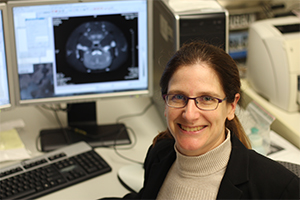Urgent Action Needed to Help Talented Women Scientists Rise to the Top
Author(s):
Melanie Martin
University of Winnipeg
SHAD Fellow and a professor of physics

The past offers a guide to the future
When I started my undergraduate degree in physics at the University of Manitoba in 1991, I knew I was on my own.
My parents — a newspaper editor and a woman who held at least two different jobs at all times; freelance writer, teacher, lab technician, administrative assistant — worked hard to provide for us, and my siblings and I never wanted. But it was always a given that we’d have to find our own way to cover the cost of university.
Thankfully, in the early 1990’s, music and hair weren’t the only things that were objectively superior to than they are today. There was a huge network of federal scholarship and bursary options.
I earned enough federal scholarship dollars both to cover my tuition and allow me to perform scientific research in the summer. The only condition was keeping a high GPA, so I made sure to do just that. Without having to work extra jobs during university or take time off to earn, I zipped through my four-year honours program, went on to earn grad school scholarships, and started my career as a taxpayer – without crippling student debt –right out of the gate.
Now I’m privileged to run the University of Winnipeg’s Magnetic Resonance Microscopy Centre. My ability to focus and follow my passion has helped me generate value for Canada. My team and I are aiming to diagnose Alzheimer’s, multiple sclerosis, and a range of other diseases faster and more accurately.
My story is a huge testament to how strong the federal government’s support for science and scholarship was before successive governments unwound that important consensus.
Today, every single one of the scholarship programs I used has been canceled. All of them. Now that I’m at the front of the classroom as a University of Winnipeg faculty member, I see the next generation of students facing all the wrong choices.
To bridge the enormous financial gap that’s opened up for even the best students, many have to take on a crippling debt load. Others split their energy – and performance – between full-time work and full-time school. Others take six years to do a four-year program. Some – and this just destroys me – give up on their grad school dreams because academic performance takes time, time takes money, and they’ve got neither.
I left Canada for the United States when successive governments aggressively dismantled the economic supports that made school viable for me. I found myself at Yale, and at one point, Canada’s industry minister attended an event there and asked to talk with all the Canadian expats before heading back to the airport. He wanted to know why we left and what could bring us back.
To put a fine point on it, I said, “Science.” Government needed to come back to the plate.
Twenty years and several elections since that encounter, things were slowly starting to change, at least tonally. I was encouraged by this week’s news of the appointment new Chief Science Advisor Dr. Mona Nemer to advise cabinet on “scientific issues of national importance.” Scared by the international ‘brain-drain’ and leading scientists leaving the country, governments of different stripes started kicking into gear.
The Natural Sciences and Engineering Research Council of Canada (NSERC) is a federal funding agency for basic research. The government began creating programs within NSERC so Canada could once again be at the forefront of scientific research. A great example is NSERC’s University Faculty Award (UFA) program which was designed to support Indigenous and female faculty in their quest for tenure and it was a step in the right direction.
But UFA was canceled for no fathomable reason. It was evidence-based policy-making at its best. Just look at its record: it was officially canceled after the last awards were given in 2008. But from 1999 when the program was founded, to 2015 when the last awards ran out, female full professors in natural sciences and engineering faculties rose from 6.8% to 11%. It was working.
That’s exactly the kind of thinking and programming and funding we need more of so that science can continue to be a boon to innovation – and equity – in Canada.
We need to do the hard work of rebuilding the national consensus that science needs strong support. And we need to re-assemble the policy and funding architecture to bring that conviction to life. That’s the only way kids like me – kids from modest means – will be able to make it on their academic potential and eventually do things like help Canada diagnose and treat disease.
That’s exactly the issue I’m going to help tackle at the Canadian Science Policy Conference on November 3 in Ottawa. I’ll be part of a roundtable convened by SHAD – a truly incredible enrichment program for high school students with a passion for STEM and entrepreneurship. About 55% of the SHAD participants are female and we’ll focus on how women can help solve the Canadian innovation crisis, partially through academic advancement.
As is so often the case with science and academia, good public policy is going to be the real difference maker. So Ottawa, here we come.
Melanie Martin is a SHAD Fellow and a Professor of Physics at the University of Winnipeg. She is the Director of the Magnetic Resonance Microscopy Centre.

